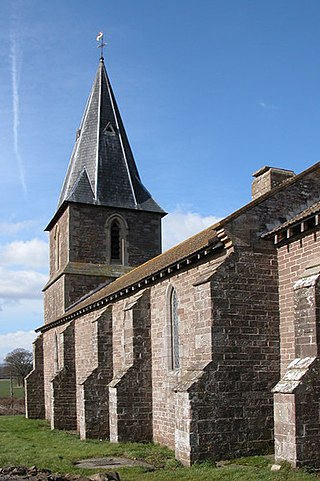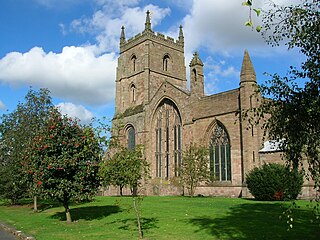Related Research Articles

Gloucester Cathedral, formally the Cathedral Church of St Peter and the Holy and Indivisible Trinity and formerly St Peter's Abbey, in Gloucester, England, stands in the north of the city near the River Severn. It originated with the establishment of a minster, Gloucester Abbey, dedicated to Saint Peter and founded by Osric, King of the Hwicce, in around 679. The subsequent history of the church is complex; Osric's foundation came under the control of the Benedictine Order at the beginning of the 11th century and in around 1058, Ealdred, Bishop of Worcester, established a new abbey "a little further from the place where it had stood". The abbey appears not to have been an initial success, by 1072, the number of attendant monks had reduced to two. The present building was begun by Abbott Serlo in about 1089, following a major fire the previous year.

Wormbridge is a village and former civil parish in Herefordshire, England, about eight miles south-west of Hereford, on the A465 road at. The neighbouring villages are Kilpeck, Didley, Howton, Treville, Ewyas Harold, Pontrilas and Crizeley. In 2001 the parish had a population of 59.

The Church of St Mary and St David is a Church of England parish church at Kilpeck in the English county of Herefordshire, about 5 miles from the border with Monmouthshire, Wales. Pevsner describes Kilpeck as "one of the most perfect Norman churches in England". Famous for its stone carvings, the church is a Grade I listed building.

The Priory Church is an Anglican parish church in Leominster, Herefordshire, England, dedicated to Saint Peter and Saint Paul. The building was constructed for a Benedictine Priory in about the 13th century, although there had been an Anglo-Saxon monastery in Leominster, possibly on the same site. In 1539 the east end of the church was destroyed along with most of the monastic buildings, but the main body of the church was preserved.
Kivernoll is a hamlet in the county of Herefordshire, England. It is part of Much Dewchurch parish. Kivernoll consists of a small number of houses along the B4348, with settlement stretching along the unclassified road to Kilpeck and the byway to Dewsall known as The Rhydd.

Goldcliff Priory was a Benedictine monastery in Goldcliff, Newport, South Wales. It was established in 1113 by Robert de Chandos as a subsidiary house of the Abbey of Bec in Normandy. The priory was built on a coastal site, now the land of Hill Farm. In the 1950s, the Monmouthshire writer Hando noted the outlines of buildings visible as grass patterns or crop marks, but by the 1970s the only remaining structural element was part of a cellar in the farm house.

Rowlestone is a village and civil parish in the county of Herefordshire in England. It is a rural area with agriculture the main source of employment, and had only 87 residents in 2004, increasing to 180 at the 2011 Census.

Leonard Stanley Priory was a priory in Gloucestershire, England. Over the years following the dissolution most of the buildings of the priory complex have been destroyed.

Flanesford Priory was an Augustinian priory in Herefordshire, England.
Saint Guthlac's Priory was a Benedictine priory in Hereford, England. It was originally founded in the early 12th century near the Church of St. Guthlac in town. After the church was ruined circa 1143, during the Anarchy, it relocated to a site between the present day Bath Street and Commercial Road at grid reference SO51534019.
Limebrook Priory was a priory in Lingen, Herefordshire, England at grid reference SO37386604.
Bromfield Priory was a priory in Shropshire, England, located at Bromfield near Ludlow.

Rumburgh Priory was a Benedictine priory located in the village of Rumburgh in the English county of Suffolk. The priory was founded in about 1065 as a cell of St Benet's Abbey at Hulme in Norfolk. At the time of the Domesday Book in 1086 it had 12 monks. The ownership of the priory was transferred to St Mary's Abbey in York towards the end of the 12th century. The monks of Rumburgh were particularly devoted to St. Bee, whom they commemorated at Michaelmas.

Upavon Priory was a small priory in Wiltshire, England.
Cardigan Priory was a Benedictine priory located in Cardigan, Ceredigion, mid-west Wales.

Treville is a rural area and former royal forest in the English county of Herefordshire. It is near Wormbridge and other small settlements.
St Kyneburgh's Chapel was established in early times near the City of Gloucester. It was dedicated to St Kyneburgh and was transferred with all its lands to Llanthony Secunda Priory by Roger Earl of Hereford between 1143 and 1155. It was situated inside Gloucester's city wall at the south gate. It was formerly a possession of St Owen's Church, Gloucester.

St Begh's Church or St Begh's Priory Church is a Roman Catholic parish church in Whitehaven, Cumbria, England. It was built from 1865 to 1868 and designed by E. W. Pugin in the Gothic Revival style. It was founded and is still administered by the Benedictines from Belmont Abbey, Herefordshire. It is located on the Coach Road in the Corkickle part of Whitehaven. It is a Grade II listed building.
References
- ↑ "Benedictine Priory, Kilpeck". Herefordshire Through Time. Herefordshire Council. Archived from the original on 9 June 2011. Retrieved 9 September 2010.
- ↑ Kilpeck Timeline at kilpeckchurch.org.uk, accessed 26 May 2020
51°58′05″N2°48′13″W / 51.9680°N 2.8036°W

